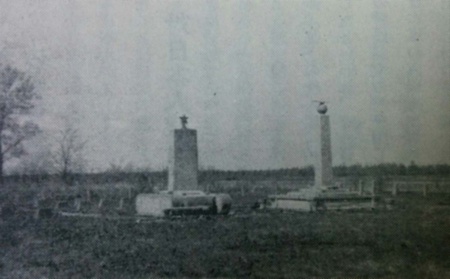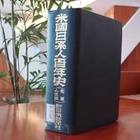In the "Centennial History," many pages are devoted to states on the West Coast, such as California, but when it comes to states in the central United States, the footprints and achievements of Japanese people are few, or perhaps there is little information available, and they are only introduced in a very limited number of pages.
The five states introduced in "Chapter 17: The Five Central States" are, from the north, Iowa, Kansas, Missouri, Oklahoma, and Arkansas.
According to statistics, the prewar Japanese population in all five states was small in 1940: 29 in Oklahoma, 19 in Kansas, 74 in Missouri, 57 in Oklahoma, and 3 in Arkansas. The reason this number increased sharply after the war is said to be due to an "increase in military brides." In 1960, the population was 599, 1,362, 1,472, 749, and 237, respectively.
If we trace the footsteps of Japanese Americans in each state...
Japanese Americans in Iowa
There are few traces of Japanese people in Iowa as farmers, but one unusual figure was Yukihiko Butsuen (from Hiroshima Prefecture), who cultivated potatoes and corn on 4,200 acres of rented land. Apart from agriculture, a small number of Japanese chick sexers came to Iowa seasonally before the war, and after the war they settled in the capital, Des Moines.
Des Moines has a large population of Scandinavians, including Norwegians, and there was little racial discrimination. The first Japanese to settle here was Kenichi Yoshinaga (a second generation Japanese who came to America) who came to work as an appraiser around 1932, followed by George Yamazaki, who came from Omaha (Nebraska) and ran a Japanese art store. Before that, there were Japanese who had studied at the University of Iowa.
After the war, there were Japanese clinics, including George Yamazaki's. There were 20 to 30 professors and foreign students at Iowa State University (Agriculture) in Ames, and 20 to 30 research students at the University of Iowa (Medicine), but they had no connection to the Japanese community.
Japanese in Kansas
Japanese people mainly worked as farmers in the area around Kansas City, the state's largest city, and in the Garden City area in the western part of the state near the Colorado border.
However, there are also traces of Japanese people unique to Kansas City. Kansas City is also known as the "City of Bridges" because it straddles the Missouri River between Kansas and Missouri. Specialized bridge construction technology developed here early on, and many researchers from Japan have stayed there.
Around 1900, Dr. Wardell, who had taught in Japan, established a bridge design and design company in the city, and many of his students and young engineers came from Japan to work there.
In the commercial sector, Japanese art stores were opened, and people from Omaha started businesses. Western-style restaurants and Japanese tea gardens also opened. At one time, some Japanese people worked in canned goods factories, but they did not last long.
Although no organization resembling a Japanese-American group was organized, there were some unusual activities.
"Dentist Kenkichi Furuichi (Chiba), who opened his practice in 1925, contributed greatly to the public and private life of the Caucasian Japanese community and played the role of a private Japanese consul. When he passed away in the autumn of 1960, the local English-language newspapers ran extensive reports, including photographs, praising his virtues."
Japanese farmers in Garden City and other areas began when people who had worked on railroad construction or farms in Colorado moved here. They cultivated sugar beets. From the end of the war until around 1960, only Akagi, Maruyama and his son, Jochu, and five or six other families continued to farm.
Japanese in Missouri
Most Japanese people live in St. Louis, the state's capital, with a few farms in the southern part of the state. As for early Japanese people, it is believed that some of them came as peddlers while traveling between the east and west of the state, as St. Louis was a key transportation hub.
In 1904, the World's Fair was held here, and in addition to Takuma Kajiwara (who was considered one of the top seven Americans for photography skills) who came from Seattle and opened a photography studio, there were other Japanese people who opened bamboo craft shops. The Japanese government also participated in the fair on a large scale, building a Japanese pavilion, and Kushibiki Yuminobu set up a Japanese tea garden and amazed people with his rickshaw.
About 400 people came for the exhibition, and while most returned home or went to other cities, some stayed and settled in the area.
During the war, the number of immigrants from other regions increased dramatically, and at one time there were around 400 families living there, but they later returned to their original homes. After the war, the Japanese Citizens Association was formed and became the center of the local Japanese community. In addition, several educational institutions for Japanese people appeared, such as naturalization schools. Outside of St. Louis, a group of Japanese people relocated to the White Farm in Azoo, southeastern Missouri, during the war, and a Japanese village briefly appeared. However, it gradually declined.
Japanese Americans in Oklahoma
Japanese people have lived mainly in the capital, Oklahoma City, since before the war, and also in the Tulsa and Bartlesville areas.
Regarding the early Japanese immigrants, it says, "It is said that the immigration of Japanese people began in the early 1900s when the Mitsui & Co. Company set up a branch office, but it was not resumed after the war."
After the war, "the number of military brides increased at an accelerating rate from around 1950, and today the number of Japanese-American residents is at an all-time high. As of 1960, the largest number of Japanese-Americans living in the area and their occupations was in Lawton (where the barracks were located), where they were all war brides. Next was Oklahoma City, where the airbase is located, and here too the majority were military brides."
Their occupations include agricultural wholesalers, photo studios, etc. No Japanese organizations were formed in the state before or after the war.
Japanese in Arkansas
The Japanese population in this state was low: nine people in 1910, five in 1920, twelve in 1930, and three in 1940, making it one of the states with the lowest Japanese populations in the United States.
However, there were many Japanese Americans in the state during the war who do not appear in these statistics. During the war, two internment camps were set up in the state, in Lore and Jerome, and a total of over 13,000 people were interned there between 1942 and 1946, which made Arkansas suddenly well-known among Japanese Americans in the United States. After the war, some of these people stayed and settled there, and the presence of military brides caused a rapid increase in the Japanese American population.
After the outbreak of the war, anti-Japanese sentiment in the state temporarily worsened.
"One example of this shocking animosity is said to be that the official in charge of overall control of the settlements in Jerome and Rohr warned his subordinates, 'Do not take your wives and children to the barbaric Japanese, as it is dangerous,' and when the Japanese moved to farms on the outskirts of Little Rock, local villagers locked their doors in fear and hid."
However, these were temporary and they have since become closer.
Around 1960, the number of Japanese people living in Arkansas included 27 people from 4 farming families, 10 people from 2 families of professors at the University of Arkansas Medical School (second generation), many military brides, foreign students, and one family of a university professor from Japan. Regarding military brides, the book states, "Many war brides lead happy family lives, but there are also a few who get divorced and raise children while working, or who end up becoming prostitutes, and are unfortunate people living in a foreign land."
A Japanese cemetery was left at the Rohr Relocation Site (internment camp), and at one time it was in ruins, but thanks to the efforts of local volunteers, including financial support from Japanese people in Chicago and Los Angeles (those with connections to the Rohr Relocation Site), a pilgrimage route was built in the fall of 1961, the cemetery was cleaned up, and it has been maintained as a national memorial cemetery. A memorial monument for the second-generation warriors and a memorial tower for the first and second-generation soldiers who died were also built.

(Note: I have used the original text as much as possible, but have made some edits. Titles have been omitted.)
*Next time we will introduce " Nikkeis in Illinois ."
© 2015 Ryusuke Kawai






